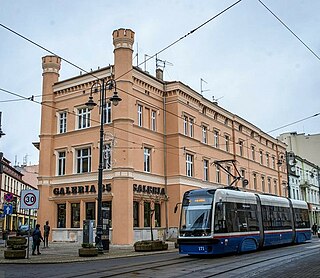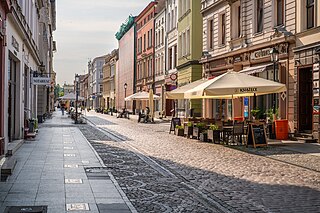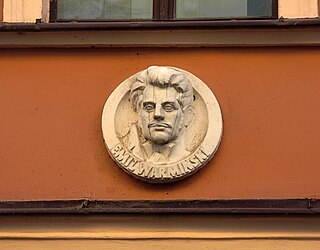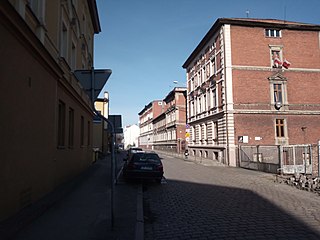
Alexander Timm House is a tenement located in Bydgoszcz, Poland, at 17 Gdańska street.

The Julius Grey house is a historical building in downtown Bydgoszcz, at 35 Gdańska Street.

Długa Street is the longest street of Old Town district in Bydgoszcz and the most important historically. It stands next to Gdańska Street and Dworcowa Street as one of the most important avenues of downtown Bydgoszcz.

Śniadecki Street is a street in downtown of Bydgoszcz, Poland. It has an important mercantile concentration.

Pomorska Street is an important street in downtown Bydgoszcz.

Wool Market square is located in Bydgoszcz, Poland. Many of its buildings are either registered on Kuyavian-Pomeranian Voivodeship heritage list, or part of Bydgoszcz local history. On its centre stands a statue of Leon Barciszewski, ancient mayor of Bydgoszcz (1932-1939).

Przyrzecze street is a street located in the old town district of Bydgoszcz, Poland. Many of its buildings are part of Bydgoszcz local history. Due to the proximity of the river, its townhouses represent a picturesque urban complex.

The Franke family was an important Prussian family of Bromberg, whose members were entrepreneurs, industrialists and businessmen from the 1820s to the eve of the First World War. Some of their edifices are still standing today in the city.

Świętego Floriana Street is located in the downtown district of Bydgoszcz, Poland. Despite its short length of roughly 200 metres (660 ft), it features many notable buildings in a variety of architectural styles, including Eclectic, Art Nouveau and early modernist. The street is named after Saint Florian.

Garbary street is located in the Okole district of Bydgoszcz city, Poland. Its development occurred during the second half of the 19th century and today it displays several buildings listed on the Kuyavian-Pomeranian Voivodeship Heritage list, with a variety of architectural styles, from eclectic to early modernist. The area also nurtured a series of local successful factories, under the Prussian and the Polish periods.

Lewin Louis Aronsohn (1850–1928) was a German banker of Jewish origin. As a liberal politician, he was a member of the regional parliament of the Province of Posen, the Prussian House of Representatives and the Prussian Constitutional Assembly. In 1918, he has been given the title of Honorary Citizen of Bydgoszcz.

Szwederowo is a district of the city of Bydgoszcz, Poland, located on its southern territory. Szwederowo population is the second largest of all Bydgoszcz districts.

Emil Warmiński was a Polish physician, social and national activist and founder of the Polish House in Bydgoszcz.
Heinrich Ernst Dietz, generally called Heinrich Dietz or Henryk Dietz, (1840–1901) was a Prussian rentier, member of the Bromberg city council, member of the Prussian parliament and a prominent philanthropist in the second half of the 19th century.
Jan Biziel (1858-1934) was a German and Polish physician, social activist, city councilor of Bydgoszcz. He was designated "Honorary Citizen of Bydgoszcz" in 1930.

Teofil Magdziński was a Polish lawyer, conspirator and activist in exile. He participated in several Polish uprisings of the second half of the 19th century. He was one of the most prominent politicians in Bydgoszcz, representative at the Reichstag and a staunch defender of Polishness.
Makrum is a firm in Bydgoszcz established in 1868, by Hermann Löhnert and manufacturing heavy industrial devices.

Adama Czartoryskiego street or Czartoryskiego street is a path located in the Old Town District of Bydgoszcz, Poland. It portrays the industrial development that the city witnessed in the middle of the 19th century.
The Peterson family was a family whose several members had a historical importance in the city of Bydgoszcz, Poland. They were influential from the beginning of the 19th century till the 1930s in the area of politics, engineering and entrepreneurship.

Władysław Piórek (1852–1926) was a Polish physician, social and national activist. He was the first person to be made Honorary Citizen of Bydgoszcz.

















